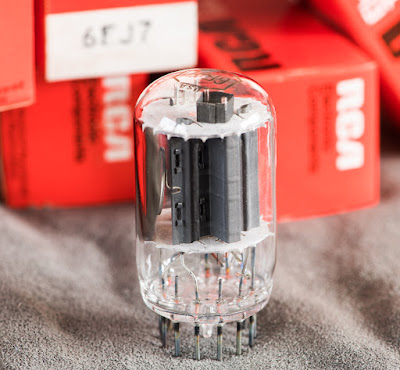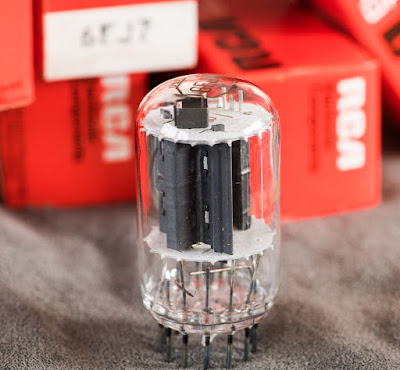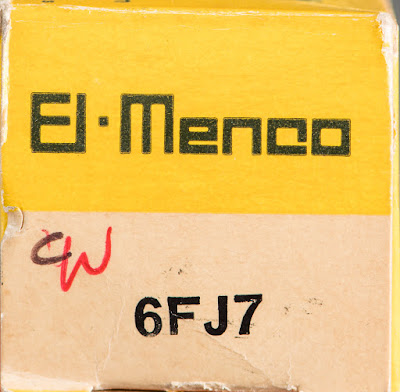After the choice of the 6FJ7 as driver tube in the recently developed 6KN6 single ended amplifiers, it is probably no surprise that this tube is featured as tube of the Month.
The 6FJ7 is a 12 pin compactron equivalent of the 6DN7. It is a dissimilar double triode, which means it has two independent triode sections with different parameters.
 The 6FJ7 shares all electrical parameters with the 6DN. It only differs in the base. The compactron base pin out is shown on the left. Most dissimilar double triodes have a low or medium mu section and a high mu section. But the 6FJ7 and 6DN7 have two sections with medium amplification factors. Section 1 has a mu of 22.5 with a plate resistance of 9kOhm and a maximum plate dissipation of 1W. The second triode has a mu of 15.4 combined with 2kOhm plate resistance and a whopping 10W maximum plate dissipation. The latter would make the second triode suitable as low power output triode as well. The combination of parameters made this tube the perfect choice as input/driver tube in the 6KN6 amplifiers. See that post for further details why this tube was chosen. All technical details can be studied in the General Electric data sheet. When I picked this tube as driver for the 6KN6 amplifiers I did not have
The 6FJ7 shares all electrical parameters with the 6DN. It only differs in the base. The compactron base pin out is shown on the left. Most dissimilar double triodes have a low or medium mu section and a high mu section. But the 6FJ7 and 6DN7 have two sections with medium amplification factors. Section 1 has a mu of 22.5 with a plate resistance of 9kOhm and a maximum plate dissipation of 1W. The second triode has a mu of 15.4 combined with 2kOhm plate resistance and a whopping 10W maximum plate dissipation. The latter would make the second triode suitable as low power output triode as well. The combination of parameters made this tube the perfect choice as input/driver tube in the 6KN6 amplifiers. See that post for further details why this tube was chosen. All technical details can be studied in the General Electric data sheet. When I picked this tube as driver for the 6KN6 amplifiers I did not have any of them in stock. So I had to buy a small selection to be able to show some variety of tubes in this post. This is a nice example that there are still many tubes out there waiting to be put to good use. Especially Compactron tubes keep being largely ignored by tube amplifier builders. So it is easy to source them. All of the tubes shown in this post have been bought within the recent weeks. Compactron tubes were manufactured at a time when the vacuum tube technology was very matured and they were produced in quite large numbers. As they were introduced when the transistor started to take over, thye did not get widely adopted but got made in large numbers, more than the market consumed. So tube dealer warehouses are still full of them. Go get some and build tube gear with compactrons!.
any of them in stock. So I had to buy a small selection to be able to show some variety of tubes in this post. This is a nice example that there are still many tubes out there waiting to be put to good use. Especially Compactron tubes keep being largely ignored by tube amplifier builders. So it is easy to source them. All of the tubes shown in this post have been bought within the recent weeks. Compactron tubes were manufactured at a time when the vacuum tube technology was very matured and they were produced in quite large numbers. As they were introduced when the transistor started to take over, thye did not get widely adopted but got made in large numbers, more than the market consumed. So tube dealer warehouses are still full of them. Go get some and build tube gear with compactrons!.As always let's start with the plate curves. Section one above and section 2 below.
And some real life curves taken from an actual tube with the tracer:
Now let me show you the small collection of 6FJ7 tubes which I acquired recently. Starting with General Electric, the inventor of the compactron base.
The tube from different angles:
Here we clearly see the higher power section on the left and the weaker triode on the right.
Some more views:
A different GE 6FJ7:
RCA:
Another RCA:
Sylvania of course also made the 6SF7:
Different style Sylvania:
Tung-Sol:
It is interesting that after decades of working with tubes you still come across brands never seen before:
El-Menco, obviously a rebrander.
International Servicemaster:
Lindal:
ITT:
So how does a 6FJ7 look inside? Let's find out by opening this one:
Glass removed:
Base removed:
The heater wires:
Both triodes separated from each other:
Section 1 cathode:
Section 1 grid:
Section 1 plate:
Section 2 cathode and grid still together:
Section 2 plate:
Section 2 cathode:
Section 2 grid:
These photos clearly show how far vacuum tube technology came along. Let's finish this presentation by showing some tube glow.
Ain't it pretty?
I hope you enjoyed this presentation of the 6FJ7
Best regards
Thomas


































































































